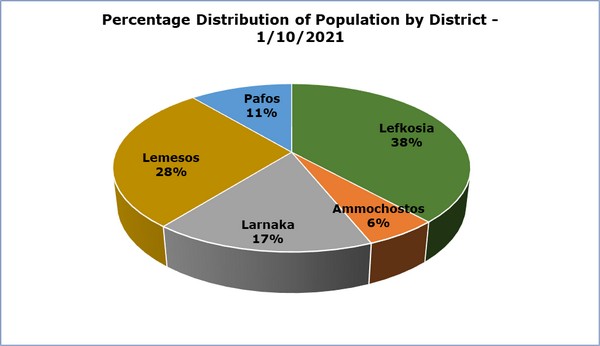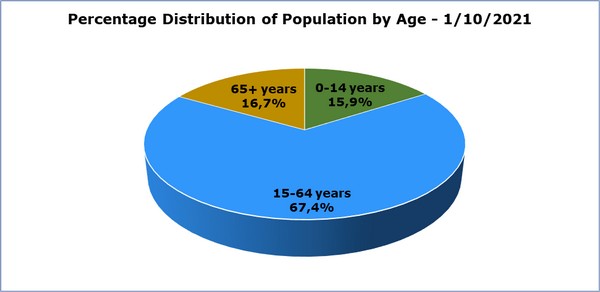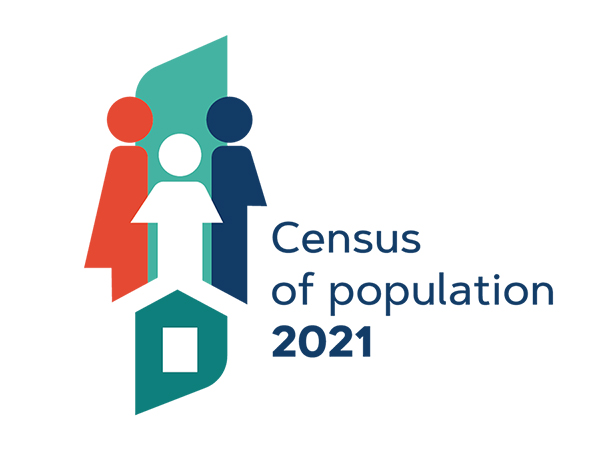Press Releases
18-05-2022 12:36
Census of Population and Housing 2021: Preliminary Results
The Statistical Service announces the preliminary results of the Census of Population and Housing 2021.
According to the preliminary results, the population in the Government controlled areas of Cyprus on the 1st of October 2021 was 918.100, recording an increase of 9,2% compared to the results of the Census of Population 2011 (840.400). A proportion of 48,6% were males and 51,4% were females.
Population by District
The population recorded in the District of Lefkosia was 351.600 persons and constituted a percentage of 38% of the total population, in the District of Lemesos 258.900 (28%), in the District of Larnaka 154.200 (17%), in the District of Pafos 101.900 (11%) and in Ammochostos 51.500 (6%).
The diagram below presents the percentage distribution of the population by District.

The Pafos District records the highest population increase compared to 2011, with a percentage of 15,4%, followed by Ammochostos with 10,5%. The Lemesos District records an increase of 10,0%, Larnaka District 7,7% and the District of Lefkosia 7,5% (Table 1).
|
Table 1 |
|||
|
District |
Population |
Population |
Percentage Increase |
|
Lefkosia |
351.600 |
327.000 |
7,5 |
|
Ammochostos |
51.500 |
46.600 |
10,5 |
|
Larnaka |
154.200 |
143.200 |
7,7 |
|
Lemesos |
258.900 |
235.300 |
10,0 |
|
Pafos |
101.900 |
88.300 |
15,4 |
|
Total |
918.100 |
840.400 |
9,2 |
Population by Age
The proportion of children below 15 was 15,9%. The proportion of persons aged 15-64 years constituted 67,4% of the total population and the proportion of persons aged 65+, 16,7%. The proportion of persons aged 65+ was higher than the proportion of children less than 15 years, demonstrating that the population is ageing. This tendency is also apparent in most European countries, which are going through the ageing process as well.

Population by Citizenship
The total number of foreign nationals amounts to 193.300 and corresponds to 21,1% of the total population. Pafos has the highest proportion of foreigners in relation to its total population, accounting for 38,0%. In the District of Lemesos a percentage of 20,5% are foreign nationals and in Larnaka 18,9%. In the Districts of Ammochostos and Lefkosia, 18,6% and 17,9% respectively of the population are foreign nationals (Table 2).
|
Table 2 |
|||||
|
District |
Total |
Cypriots |
Foreigners |
||
|
Population |
Percentage (%) |
Population |
Percentage (%) |
||
|
Lefkosia |
351.600 |
288.800 |
82,1 |
62.800 |
17,9 |
|
Ammochostos |
51.500 |
41.900 |
81,4 |
9.600 |
18,6 |
|
Larnaka |
154.200 |
125.100 |
81,1 |
29.100 |
18,9 |
|
Lemesos |
258.900 |
205.800 |
79,5 |
53.100 |
20,5 |
|
Pafos |
101.900 |
63.200 |
62,0 |
38.700 |
38,0 |
|
Total |
918.100 |
724.800 |
78,9 |
193.300 |
21,1 |
Average Household Size
The average household size presents a gradual decrease, reaching 2,6 persons per household in 2021, compared to 4,0 persons which were enumerated in the Census of 1976, 3,2 persons in the Census of 1992 and 2,8 persons in the last Census of Population (2011). At District level, the highest average household size is recorded in the District of Ammochostos and the lowest household size in Pafos (Table 3).
|
Table 3 |
||||
|
District |
Average Household Size |
|||
|
2021 |
2011 |
1992 |
1976 |
|
|
Lefkosia |
2,6 |
2,7 |
3,2 |
4,0 |
|
Ammochostos |
2,8 |
2,9 |
3,4 |
4,2 |
|
Larnaka |
2,7 |
2,9 |
3,3 |
4,1 |
|
Lemesos |
2,6 |
2,8 |
3,2 |
3,9 |
|
Pafos |
2,5 |
2,7 |
3,1 |
3,7 |
|
Total |
2,6 |
2,8 |
3,2 |
4,0 |
The Statistical Service will be able to provide more detailed tables at a later stage. The data that will be produced will be announced and published on the website of the Statistical Service.
The Statistical Service would like to express its sincere appreciation to all citizens for providing the required information and would like to assure that all data recorded in the questionnaires as well as the information processed from administrative sources, will be treated as confidential and will be used solely for statistical purposes.
METHODOLOGICAL INFORMATION
The purpose of the Census of Population and Housing, which started in October 2021, was the complete and accurate geographical coverage of all housing units, institutions, households and individuals, Cypriot and foreign nationals, who had their usual residence in the Government controlled areas on the 1st of October 2021.
The Census is an important source of information and of statistical data and is usually conducted at regular intervals of 10 years. It is the most costly and demanding project carried out by the Statistical Service. The last Census of Population was conducted in 2011.
This press release presents provisional data which may be revised after the final processing and validation take place, procedures which are necessary for providing high-quality statistical information.
Data Collection Method
According to the original planning, the collection of data would be carried out through personal or telephone interviews (traditional method), with the use of tablets, or with the completion of paper questionnaires by the respondents themselves.
A total of 1.000 enumerators would be responsible for the collection of data in all Districts. Due to the fact that there was not enough interest from candidates, a much lower number of enumerators was employed, having a negative impact on the timeframe of the Census. In addition to that, the exceptional conditions and the restrictions that were in place due to the coronavirus pandemic (COVID-19) constituted another factor that inhibited the smooth development of the project, thus setting the completion of the Census outside the initially planned deadline (end of December 2021).
In order to complete the project, it was therefore necessary to modify the initial method of data collection. In particular, the new methods adopted involved the use of administrative data as additional sources of information as well as the use of modern technology. The administrative sources used for this purpose, following the approval by the Commissioner for Personal Data Protection, provided information on the main demographic characteristics of the population, such as the place of residence, sex, age, citizenship etc. These sources mainly included the Health Insurance Organisation Beneficiaries data base, the Births Register, the Deaths Register as well as the Population Register.
The preliminary results were obtained both from the collection of data using the traditional method (achieving up to the moment a coverage of 66%) and from administrative sources (to cover the remaining population). Data collection and data validations will continue to take place, either through personal/telephone interviews or by further processing of the available administrative sources, in order to complete the Census.
The use of administrative sources for the purpose of the Population Census is a methodological approach broadly used in many European countries for some years now. According to the latest information available, a proportion of 38% of EU countries has chosen to conduct the Census of Population 2021 exclusively from administrative sources, whereas an equally significant proportion of countries (35%) has chosen to use both the traditional Census and the use of administrative sources (combined Census). The traditional method of data collection with interviews is still used by 27% of EU countries.
The aim is that the framework that will result from the Census of Population will constitute a Dynamic Statistical Population Register which will be updated on an ongoing basis from various administrative sources. As a result, it will no longer be necessary to conduct a door-to-door Population Census, covering the total population. The Dynamic Statistical Population Register will be the basis for the production of annual population data and demographic indicators, providing timely information that will facilitate state policy and planning.
Legal Framework and Data Protection
The Census of Population 2021 is conducted in all EU Member States, following common concepts and definitions, under Regulation (EC) No. 763/2008 of the European Parliament and of the Council of 9 July 2008 on population and housing censuses.
The Census in Cyprus is also conducted in accordance to the Official Statistics Law of 2021 (Law No. 25(Ι)/2021). Based on the provisions of the Law, the data collected are treated as confidential and are used solely for statistical purposes.
Statistical confidentiality is strictly applied by the Statistical Service. The internal procedures resulting from the application of statistical confidentiality, fully cover the provisions of the General Data Protection Regulation (EU) 2016/679 (GDPR), ensuring the protection of data at every stage, from collection to publication. All data collected will be aggregated and disseminated without directly or indirectly revealing the identity of the persons who provided the data.
(MV/ECHR)
Relevant Press Releases

04-04-2025 15:31
Revenue from Tourism: January 2025

04-04-2025 14:58
Industrial Turnover Index: January 2025

04-04-2025 14:21
Registered Unemployed: March 2025

03-04-2025 14:22
Consumer Price Index (CPI): March 2025

28-03-2025 18:12
European Statistics Competition, National Phase




